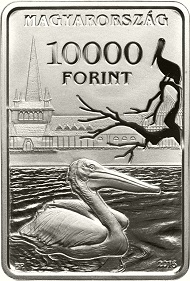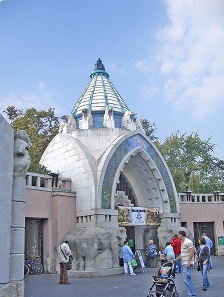September 15, 2016 – The Metropolitan Zoo and Botanical Garden at Budapest first opened its gates at noon on 9 August 1866 and will be celebrating its 150th anniversary in 2016. To mark this special date, the Magyar Nemzeti Bank is issuing a 10,000-forint silver commemorative coin and an identical 2,000-forint non-ferrous commemorative coin, designed by Gábor Kereszthury.
Hungary / 10,000 Forint / Silver .925 / 31.46g / 39.6mm / Design: Gábor Kereszthury / Mintage: 3,000.
The front of the coin depicts a bird native to the Carpathian Basin, the great white pelican, with the Bird House designed by Károly Kós in the background. The image on the coin also includes the silhouette of a pelican sitting on a bare tree. The back features an image of a white rhinoceros and its calf, against the backdrop of the Zoo’s Great Rock, which was the work of sculptors Gyula Benke and Josef Botti, and engineer Gyula Végh.
Entry to the Budapest Zoo. Photo: Martin Belam (currybet) / https://creativecommons.org/licenses/by-sa/2.0/deed.en
The founders of the Budapest Zoo included geologist József Szabó, the director of National Museum Ágoston Kubinyi, the director of the University Botanical Gardens József Gerenday, and zoologist/ethnographer János Xántus. The original buildings were designed by two of the period’s renowned architects, Antal Szkalnitzky and Henrik Koch Jr., but – with the exception of the Bagolyvár – none of these structures are still standing today.
The Budapest Zoo – past and present
In the early days, along with Hungarian species, the Zoo also housed many unusual animals, but there were no lions, tigers or elephants. The first giraffe arrived in 1868, as a gift from Franz Joseph I of Austria. The first Lion House was built in 1876 and tigers were also on display there. Later, the Zoo also added elephants, hippopotamuses and rhinoceros. In the interests of maintaining the institution, operation of the Zoo was continued by the Animal and Plant Society, which added shows to the programme. In 1896, despite all the efforts the operator became insolvent due to the high expenses.
However, the Zoo continued to exist and in 1907 the City of Budapest took control and completely rebuilt the Zoo under the leadership of Mayor István Bárczy. At the re-opening ceremonies on 20 May 1912, the new Main Gate and many of the current buildings were unveiled. The Budapest Zoo became one of Europe’s most beautiful and modern zoos.
Unfortunately, it was completely destroyed in WWII: not a single building was left intact and of the more than 2,000 animals, only about 15 survived the siege. Reconstruction progressed steadily and significant modernisation took place in the 1960s and 1970s, paving the way for new developments, but by the time of the political transition a full-scale renovation was necessary once again.
The reconstruction project started in 1994 with renovation of the listed buildings for which the Zoo was known around the world and which gave it such a special atmosphere. In addition, new buildings were erected and the animals’ living areas were modernised and made more natural. During this period, there were a number of important achievements: for example, the world’s first rhinoceros conceived using artificial insemination was born at the Budapest Zoo. Currently, the Zoo has its first-ever opportunity to expand its territory.
More information on this new issue is available here.
This is the website of the Hungarian Mint.
If you want to learn more about the Budapest Zoo, just click here.
And the official website also tells you more about the Zoo’s history.







